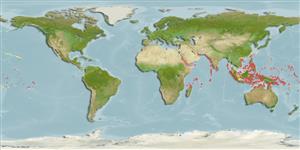Common names from other countries
Teleostei (teleosts) >
Anguilliformes (Eels and morays) >
Ophichthidae (Snake eels) > Myrophinae
Etymology: Muraenichthys: Latin,muraena = morey eel + Greek, ichtys = fish (Ref. 45335).
More on author: Bleeker.
Environment: milieu / climate zone / depth range / distribution range
Ecology
Marine; reef-associated; depth range 1 - 19 m (Ref. 86942). Tropical; 30°N - 15°S
Indo-Pacific: Persian Gulf (Ref. 68964), Red Sea (Ref. 33390) and East Africa to Samoa, north to the Ryukyu Islands, south to Australia; Caroline and Marshall islands in Micronesia.
Size / Weight / Age
Maturity: Lm ? range ? - ? cm
Max length : 24.0 cm TL male/unsexed; (Ref. 1602); common length : 8.0 cm TL male/unsexed; (Ref. 30573)
Found in reef flats and lagoons to at least 13 m. Burrows in soft bottoms (Ref. 30573). Benthic (Ref. 58302). Caught in bags or nets, or by digging (Ref. 30573). Used as shark bait (Ref. 30573).
Life cycle and mating behavior
Maturity | Reproduction | Spawning | Eggs | Fecundity | Larvae
Myers, R.F., 1991. Micronesian reef fishes. Second Ed. Coral Graphics, Barrigada, Guam. 298 p. (Ref. 1602)
IUCN Red List Status (Ref. 130435)
CITES (Ref. 128078)
Not Evaluated
Threat to humans
Harmless
Human uses
Fisheries: minor commercial; bait: usually
More information
Common namesSynonymsMetabolismPredatorsEcotoxicologyReproductionMaturitySpawningFecundityEggsEgg development
ReferencesAquacultureAquaculture profileStrainsGeneticsElectrophoresesHeritabilityDiseasesProcessingMass conversion
Tools
Can't connect to MySQL database fbquizv2. Errorcode: Too many connections
